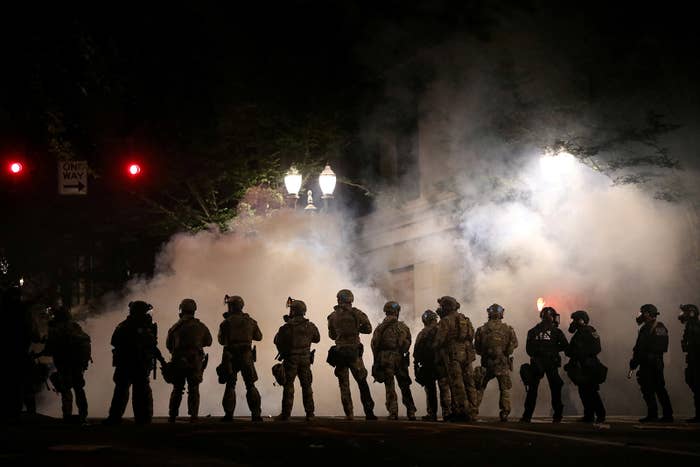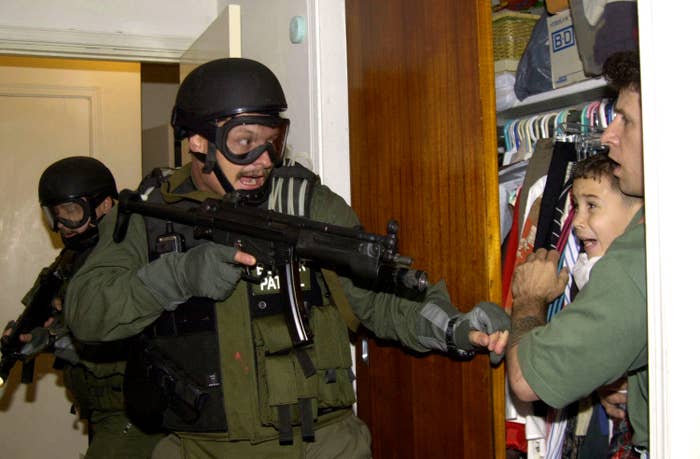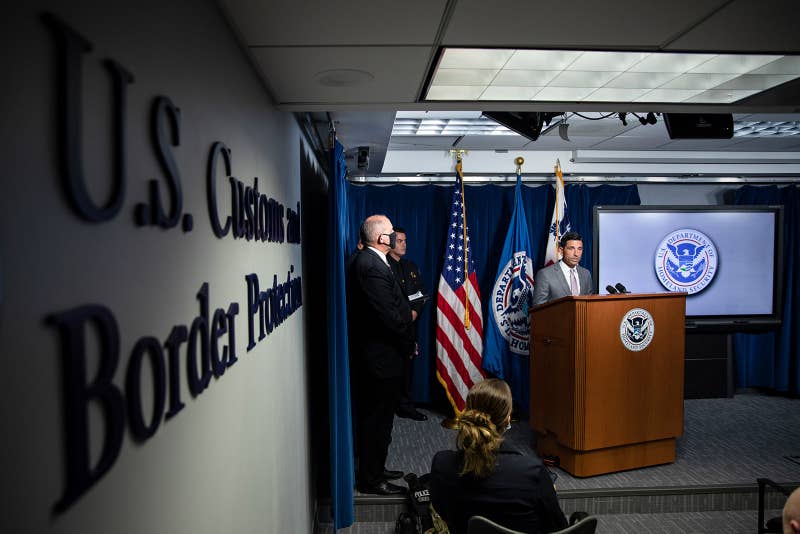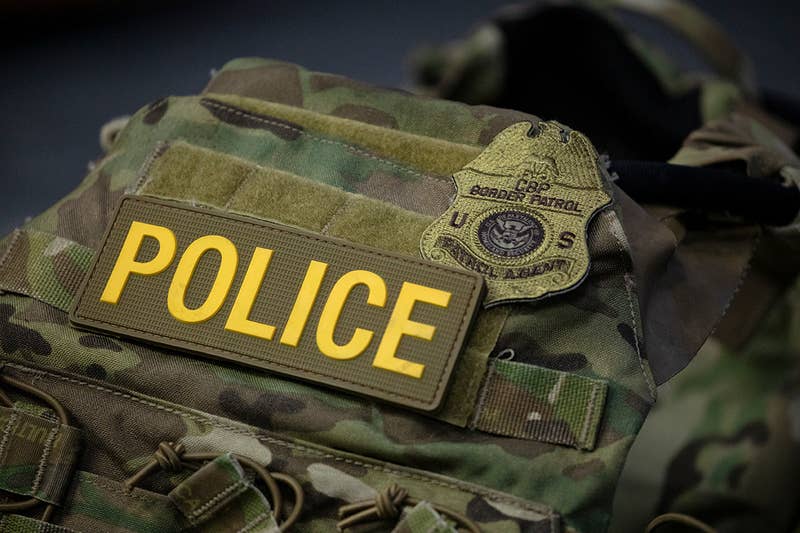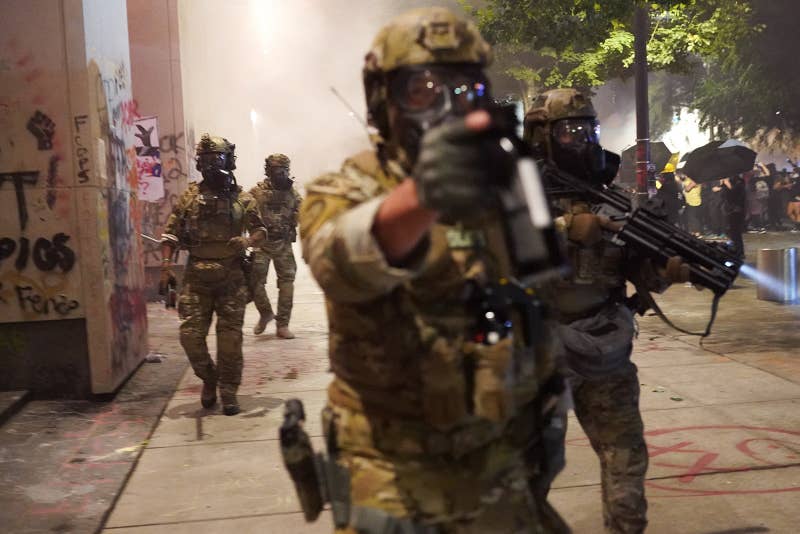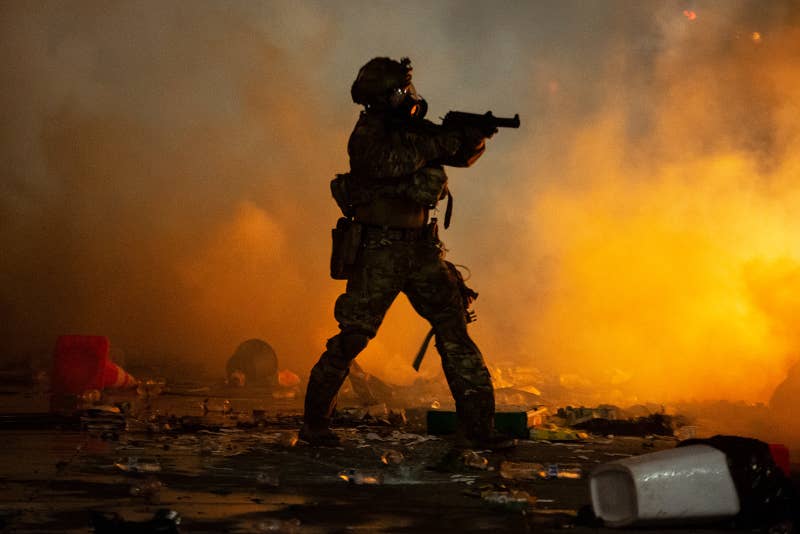Teachers who organized massive protests and strikes in 2018 are planning new activism to protest how their states and school districts are handling the coronavirus.
Ryan Brooks BuzzFeed News Reporter
Posted on July 27, 2020, at 2:00 p.m. ET
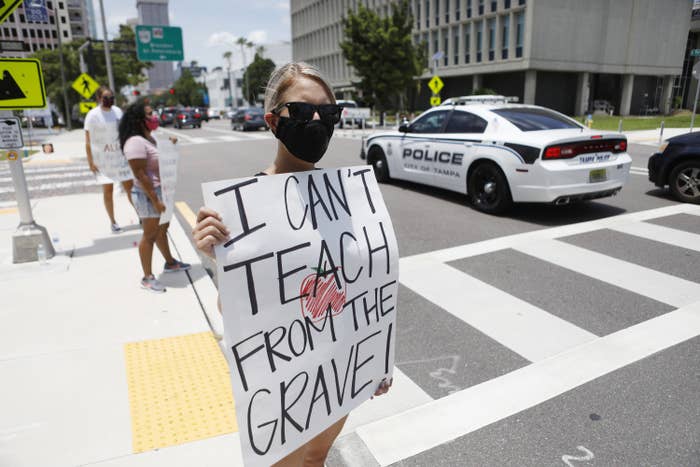
Octavio Jones / Getty Images
A middle school teacher protests in front of the Hillsborough County Schools District Office on July 16 in Tampa, Florida.
Posted on July 27, 2020, at 2:00 p.m. ET

Octavio Jones / Getty Images
A middle school teacher protests in front of the Hillsborough County Schools District Office on July 16 in Tampa, Florida.
Teachers across the country have begun organizing protests to voice concerns about the Trump administration’s push for schools to reopen in the fall despite the coronavirus pandemic and to pressure school districts to delay the start of face-to-face instruction.
Educators who have been organizing independently in cities across the United States told BuzzFeed News they’re frustrated by the Trump administration’s campaign to return to school with no national plan to keep teachers and students from spreading the coronavirus and little to no funding for personal protective equipment.
Organizers from education advocacy movements like Red for Ed, which sparked a national movement for more school funding and better pay for teachers in 2018 and 2019, are focusing on whether and when teachers and students should return to classrooms as coronavirus cases surge.
“It’s one of those things where the teachers have been like, ‘I’ve been taken advantage of for one year, five years, 32 years, and now you’re putting my physical well-being in jeopardy — it’s not worth this, and that’s something that teachers don’t take lightly,” Lisa Ellis, the founder of the South Carolina for Education movement, told BuzzFeed News. “A decision to leave the classroom weighs very heavily on a teacher’s decision. We’ve been told, ‘Well, just do it for the children!’ and the gaslighting that goes along with that, but it’s finally like, ‘Nope! At the end of the day, my life and my health is more important than any of this!’”
In school districts across the country, teachers are organizing motor protests at state capitols, writing letters to governors and state legislators, and pressuring school boards to consider delaying the start of in-school instruction until the coronavirus outbreaks begin to subside in their communities. And in the weeks leading up to the start of the school year, many teachers have begun voicing concerns about their districts’ lack of plans about keeping them safe if they do return to classrooms.
“This is going to tip teachers that were already on the fence about not teaching any longer into the territory of this is certainly not worth it, if they were thinking, Maybe I can hang in a little bit longer,” Ellis said. “The number one concern is the fact that nobody seems to care about the physical risk of teachers going back into the classroom — even with the hybrid models that are being presented, the students may not be there all week, but the teachers have to be there all five, and we have to work with all of the students.”
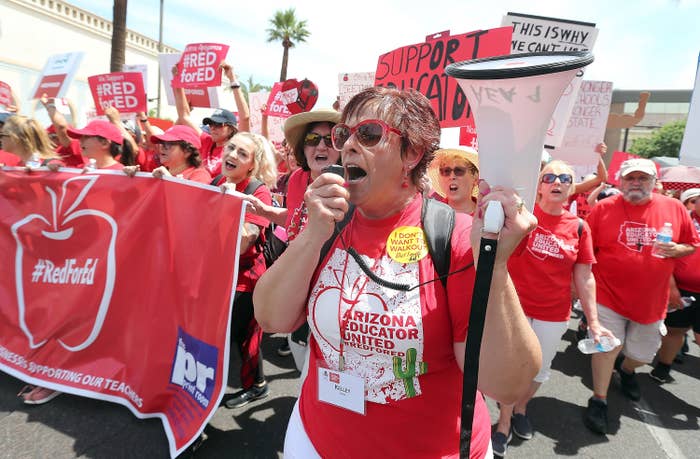
Ralph Freso / Getty Images
Teachers march through downtown Phoenix on their way to the State Capitol during a rally for the #REDforED movement on April 26, 2018.
In South Carolina, organizers told BuzzFeed News that they’ve heard from multiple teachers who have decided to look for employment in other industries or who have decided to retire early. In one school district in the state, 21 positions have been left vacant since the start of the pandemic.
In Arizona, where teachers voted to walk out during a strike in 2018 in conjunction with the Red for Ed protests, teachers have been frustrated by Republican Gov. Doug Ducey’s communication and plans around school reopenings. Organizers with Arizona Educators United have been hosting protests in their districts to push them to adopt plans to continue virtual learning or delay the start of the in-person school year until cases are under control.
Last month, Ducey delayed the start of the school year to Aug. 17 as coronavirus cases began to surge in the state, but educators in districts across the state say the decisions on how schools should operate once the school year is in session have largely been left up to the districts in a frustrating cycle that has left some teachers in the dark. Wes Oswald, a third-grade teacher with the Tucson Unified School District and a member of the Arizona Educators United group, told BuzzFeed News that for teachers in Arizona, the school year’s early start date has made the issue more concerning for them.
In June, an Arizona first-grade teacher died after she and two other teachers who had been sharing the same classroom for remote instruction all contracted COVID-19. Teachers have pointed to that case as justification for their concerns over how they will keep themselves and their students safe when they return to their classrooms.
Saani Niri, another board member of the SC for Ed organization, told BuzzFeed News that they’d seen an uptick in messages from teachers who’d decided to take a closer look at how their elected officials have been supporting education in the state. “I think for the first time in a very long time educators are waking up like, ‘Wait a minute! They’re doing what?’ and we’re seeing it across our social media pages,” Niri said.
SC for Ed said that while it's a nonpartisan organization, it has highlighted what politicians have done for education in the state and have provided educators with those records. It said that it is considering another push to have people consider voting around education in the fall, after a summer that has seen public schooling in the spotlight as President Trump has made school reopenings into an electoral issue.
On the national level, Oswald says he’s sat in on town halls that have been planned by education advocacy groups to plan protests and to discuss teacher demands for returning to their classrooms. Online, teachers have been posting about a refuse-to-return movement, which has called for school districts to delay the start of face-to-face instruction until their counties have had 14 days without any new coronavirus cases. Nearly 85,000 people have signed a petition calling for the suggestion to be implemented, even as state officials and the federal government encourage students and teachers to head back to schools.
“Our governor doesn’t have our interests in mind. He just wants the economy to open. He’s got his sights set on elections,” Oswald said. “I don’t expect much of anything positive from him unless we have some major actions or if we’re pushed to go on a strike.”
“I hope that’s not what happens, but we’ve done it before and we’ve got the practice,” he said. “But those kinds of situations are scary for everyone. Especially for the people who are planning them.”
MORE ON SCHOOL REOPENINGS
Trump Made School Reopenings An Election Issue. The Voters He Needs Just Don’t Agree With Him.
Educators who have been organizing independently in cities across the United States told BuzzFeed News they’re frustrated by the Trump administration’s campaign to return to school with no national plan to keep teachers and students from spreading the coronavirus and little to no funding for personal protective equipment.
Organizers from education advocacy movements like Red for Ed, which sparked a national movement for more school funding and better pay for teachers in 2018 and 2019, are focusing on whether and when teachers and students should return to classrooms as coronavirus cases surge.
“It’s one of those things where the teachers have been like, ‘I’ve been taken advantage of for one year, five years, 32 years, and now you’re putting my physical well-being in jeopardy — it’s not worth this, and that’s something that teachers don’t take lightly,” Lisa Ellis, the founder of the South Carolina for Education movement, told BuzzFeed News. “A decision to leave the classroom weighs very heavily on a teacher’s decision. We’ve been told, ‘Well, just do it for the children!’ and the gaslighting that goes along with that, but it’s finally like, ‘Nope! At the end of the day, my life and my health is more important than any of this!’”
In school districts across the country, teachers are organizing motor protests at state capitols, writing letters to governors and state legislators, and pressuring school boards to consider delaying the start of in-school instruction until the coronavirus outbreaks begin to subside in their communities. And in the weeks leading up to the start of the school year, many teachers have begun voicing concerns about their districts’ lack of plans about keeping them safe if they do return to classrooms.
“This is going to tip teachers that were already on the fence about not teaching any longer into the territory of this is certainly not worth it, if they were thinking, Maybe I can hang in a little bit longer,” Ellis said. “The number one concern is the fact that nobody seems to care about the physical risk of teachers going back into the classroom — even with the hybrid models that are being presented, the students may not be there all week, but the teachers have to be there all five, and we have to work with all of the students.”

Ralph Freso / Getty Images
Teachers march through downtown Phoenix on their way to the State Capitol during a rally for the #REDforED movement on April 26, 2018.
In South Carolina, organizers told BuzzFeed News that they’ve heard from multiple teachers who have decided to look for employment in other industries or who have decided to retire early. In one school district in the state, 21 positions have been left vacant since the start of the pandemic.
In Arizona, where teachers voted to walk out during a strike in 2018 in conjunction with the Red for Ed protests, teachers have been frustrated by Republican Gov. Doug Ducey’s communication and plans around school reopenings. Organizers with Arizona Educators United have been hosting protests in their districts to push them to adopt plans to continue virtual learning or delay the start of the in-person school year until cases are under control.
Last month, Ducey delayed the start of the school year to Aug. 17 as coronavirus cases began to surge in the state, but educators in districts across the state say the decisions on how schools should operate once the school year is in session have largely been left up to the districts in a frustrating cycle that has left some teachers in the dark. Wes Oswald, a third-grade teacher with the Tucson Unified School District and a member of the Arizona Educators United group, told BuzzFeed News that for teachers in Arizona, the school year’s early start date has made the issue more concerning for them.
In June, an Arizona first-grade teacher died after she and two other teachers who had been sharing the same classroom for remote instruction all contracted COVID-19. Teachers have pointed to that case as justification for their concerns over how they will keep themselves and their students safe when they return to their classrooms.
Saani Niri, another board member of the SC for Ed organization, told BuzzFeed News that they’d seen an uptick in messages from teachers who’d decided to take a closer look at how their elected officials have been supporting education in the state. “I think for the first time in a very long time educators are waking up like, ‘Wait a minute! They’re doing what?’ and we’re seeing it across our social media pages,” Niri said.
SC for Ed said that while it's a nonpartisan organization, it has highlighted what politicians have done for education in the state and have provided educators with those records. It said that it is considering another push to have people consider voting around education in the fall, after a summer that has seen public schooling in the spotlight as President Trump has made school reopenings into an electoral issue.
On the national level, Oswald says he’s sat in on town halls that have been planned by education advocacy groups to plan protests and to discuss teacher demands for returning to their classrooms. Online, teachers have been posting about a refuse-to-return movement, which has called for school districts to delay the start of face-to-face instruction until their counties have had 14 days without any new coronavirus cases. Nearly 85,000 people have signed a petition calling for the suggestion to be implemented, even as state officials and the federal government encourage students and teachers to head back to schools.
“Our governor doesn’t have our interests in mind. He just wants the economy to open. He’s got his sights set on elections,” Oswald said. “I don’t expect much of anything positive from him unless we have some major actions or if we’re pushed to go on a strike.”
“I hope that’s not what happens, but we’ve done it before and we’ve got the practice,” he said. “But those kinds of situations are scary for everyone. Especially for the people who are planning them.”
MORE ON SCHOOL REOPENINGS
Trump Made School Reopenings An Election Issue. The Voters He Needs Just Don’t Agree With Him.
Molly Hensley-Clancy · July 24, 2020
Caroline O'Donovan · July 16, 2020

Ryan Brooks is a politics reporter for BuzzFeed News and is based in New York.

Ryan Brooks is a politics reporter for BuzzFeed News and is based in New York.
